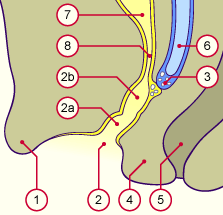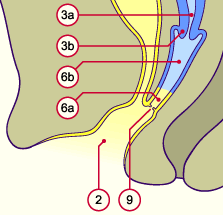
1
2
2a
2b
3
4
5
6
7
8 |
Genital tubercle
Vestibule
SUG: Phallic part
SUG: Lower part of the pelvic part
Vaginal plate
Perineum
Rectum
Utero-vaginal canal
Urinary bladder
Urethra: From the upper portion of the pelvic part of the definitive SUG |
|
|
|

2
3a
3b
6a
6b
9 |
Vaginal vestibule
Uterine cavity
Uterine cervix
Vagina: Lower fourth out of endoderm
Vagina: Upper 3/4 out of mesoderm
Hymen |
|
|
|
Fig. 51
In females, the development of the SUG begins in the 3rd month, at the same time as the formation of the vagina.
Fig. 52
The pelvic part of the SUG has shrunk and will be retracted into the phallic part in order to form the definitive vaginal vestibule.
|

